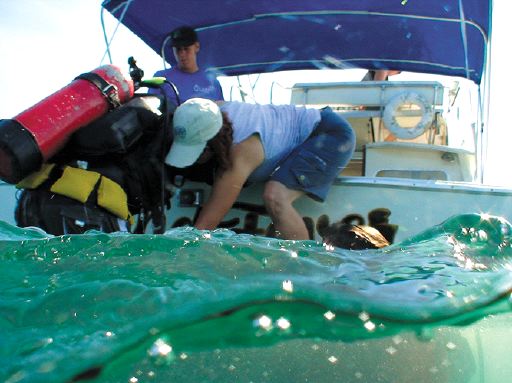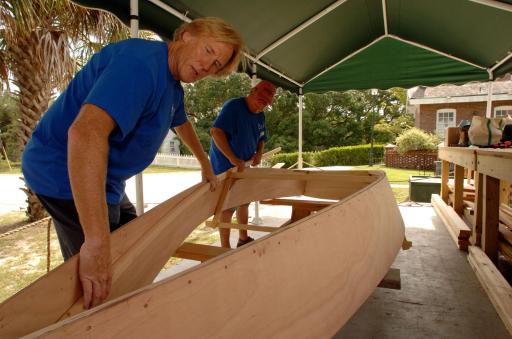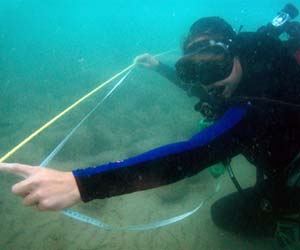
Since the start of this years fieldwork (July 1), LAMP archaeologists have been working hard to implement the inaugural season of the First Coast Maritime Archaeology Project. This major program of research and public archaeology was made possible by a Special Category historical preservation grant from the State of Florida’s Division of Historical Resources. Part of our mission is to spread the word about our work and the rich maritime history of Florida’s First Coast, and one of the most effective ways to do this is through widespread media exposure. With the help of Beau, the Lighthouse’s public relations expert, we have received some great press lately.
The opening salvo of the First Coast Maritime Archaeology Project, and in particular an archaeological field school practicum with Flinders University, attracted lots of attention from newspaper reporters in both St. Augustine and Jacksonville. The best article to date was written by Paulette Perhach at the St. Augustine Record and was published on the front page last Sunday (5 August 2007):
Heading out to their “office,” the staff of LAMP unloads cartfuls of masks, tanks and gear onto Island Fever, their 28-foot fishing boat turned research vessel.
Leading the crew is Chuck Meide, director of the Lighthouse Archaeological Maritime Program, or LAMP, the happy recipient of a $280,000 grant for the First Coast Maritime Archaeology Project and the owners of some new toys that they hope will help uncover more about the First Coast’s maritime history. “This is more than we’ve ever gotten combined,” says Meide, in his official uniform of T-shirt, shorts, flip-flops and a blond beach bum’s haircut. “We really are being set up well. Even when the money stops, we’ll have the tools that will keep us going full speed ahead.”
Read the entire article online by clicking here (registration required, just takes a minute and is free)
Accompanying the online article is a companion video program on the Record‘s webpage. This footage was taken and edited by Matt Mariott, a photographer for Sports Illustrated who spent the day with us on our research vessel along with Paulette. His video is pretty good, and includes some interview footage and lots of underwater shots.
Another great article came out in the Florida Times-Union last Monday (30 July 2007). This one was focused on the LAMP Boatworks, our traditional wooden boatbuilding program. This was really a great article and highlighted the great work our volunteers are doing at making this new program come alive.
ST. AUGUSTINE – Volunteers are trying to revive the craft of wooden boat building with plans to get a small fleet afloat in time for this historic city’s 450th birthday.
They’re gearing up on traditional tools like felling axes and shipwright’s adzes, preparing to square tree trunks into seaworthy lumber just as settlers did centuries ago.
The group, officially started in June, is coming together as a project of the St. Augustine Lighthouse Archaeological Maritime Program. Sam Turner, the lighthouse’s archaeology director, said plans are to replicate the vessels that brought goods and people ashore in St. Augustine, like the 16th century Spanish chalupa or the 18th century British yawl.
For now, the volunteers are starting slow, using modern tools and a pressed-wood kit to build a rowboat known as a Bevin’s skiff . . .

Read the entire boatbuilding article at the Times-Union webpage by clicking here.
Yet another article came out in the Times-Union the day before. This one was front page on the Sunday edition, about as good press as one could hope for. But it was actually my least favorite article, as its primary focus was on “wreck hunters,” and it included some highlights on local treasure hunters. What the article could have done better was discuss in more detail how the methods used by treasure hunters on a shipwreck causes a direct loss of knowledge. This is knowledge about the past that is lost forever, but knowledge that could have been recovered by archaeologists using techniques more similar to CSI forensics specialists than those of Indiana Jones. At least the issue was raised:
“It’s the first question you get: Have you found any gold?” said Chuck Meide, director of St. Augustine’s Lighthouse Maritime Archaeological Project.
Being called a treasure hunter gets his teeth gritting.
Meide said he became an underwater archaeologist to try to shed light on history’s unanswered questions, not to get rich. His idea of a big score would be finding one of the ships that undoubtedly sank in the 1500s as Spanish explorers settled the region, a difficult prospect as the shifting sands of the sea floor have swallowed the vessels deep under the surface.
A treasure hunter, rummaging through a wreck site only for the jewels, can destroy historical secrets before their lessons are learned, he said.
“You would never do that on land,” Meide said. “You wouldn’t go to Mount Vernon with a bulldozer and just start throwing out everything you didn’t think was worth anything.”
In the original newspaper print version, the photos of the treasure hunters and their loot dwarfs the pictures of archaeologists, suggesting a slant to the article. This isn’t apparent on the online version of the article, which ran a photo of a LAMP diver at work:

Ironically, on the Times-Union webpage, this image of an archaeologist is titled “Treasure.” Its a shame because there is so much confusion among the general pubic when it comes to the differences between treasure hunters and archaeologists. The way to tell the difference? Archaeologists use painstakingly slow, scientific methods, take elaborate notes, drawings, measurements, etc., pay specialists fees for scientific analysis, and retain the collection of recovered artifacts so that all are available to be studied by scholars and seen by the public. Treasure hunters, even the ones who call themselves archaeologists, always fail one or more of these criteria.
But regardless, this article at least does address the problem, and it got really wide circulation. Along with the other two articles, this kind of exposure really propels LAMP forward and helps get our name out there.
Can’t wait to see what’s in the paper next week!
Photos courtesy of the St. Augustine Record and the Florida Times-Union. The third photograph is a LAMP photo provided to the Times-Union.

